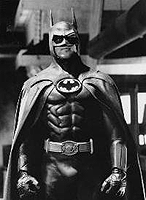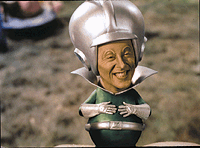Gerard Raiti looks into why some cartoons make successful live-action features while others don't. Academy Award-winning producer Bruce Cohen helps out.
Cartoons and live-action films are extremely different. Any established movie critic or five-year-old can attest to that. Yet strangely enough, within the last decade studios like Walt Disney, Universal and Warner Bros. have produced a growing niche of live-action adaptations of beloved, nearly iconic cartoons. So in keeping with the new millennium, now is the germane time to ask, "Why sully cartoons by adapting them to live-action?"

For most in the entertainment industry, the answer is twofold: to make money and to entertain audiences. The catalyst and culprit for the recent trend of live-action adaptations is none other than The Dark Knight himself, Batman. Warner Bros.' 1989 film starring Michael Keaton and Jack Nicholson garnered over $413.2 million worldwide and launched a franchise. Batman proved how something as zany and unrealistic as a comic book or a cartoon could effectively be molded into a blockbuster. (Granted, there were earlier live-action Batman movies, not to mention Christopher Reeves' Superman films, but none reached the box-office stature of 1989's Batman.)
Unfortunately, the sweet peach that was live-action adaptations quickly became rotten. By the early '90s, they were branded as "cheesy" or "B-rated" despite sometimes enormous budgets. The box-office figures generally speak for themselves as far as these adaptations are concerned. For example, consider the domestic totals (in millions courtesy of Box Office Report) for the following motley crew of films: Richie Rich ($38.06), The Flintstones in Viva Rock Vegas ($34.92), Dudley Do-Right (
GR: Why was the first Flintstones movie more successful?
BC:
That's hard to say. It was probably the novelty of the film. People had never seen Bedrock brought to life before. This was huge! It's always fun for fans to see their childhood characters come to life for the first time.
GR:
What originally enticed you to produce the first Flintstones movie?
BC:
I've always been a fan. It's a tremendous challenge to undertake. At the same time, it's the perfect opportunity to entertain millions of people. The Flintstones personifies family entertainment.
GR:
If you could have changed anything about Viva Rock Vegas that would have made it more successful, what would you have changed and why? Also, did you suspect at anytime it was of a lower caliber than its predecessor?
BC:
No, not at all! In fact, everyone involved in [Viva Rock Vegas] felt it was better than the original. The only thing I would have changed is the way it was marketed and reviewed. For whatever reason, people never gave the movie a chance. On our end, we tried to make the best sequel possible, and we thought we succeeded. So, no, there's really nothing I would have changed because I'm satisfied with how [Viva Rock Vegas] turned out.

GR:
Why did the international audiences take to Viva Rock Vegas more than the Americans?
BC:
The international audience is less review dependent. They knew they enjoyed the first film and assumed the second would be equally good. And the new cast was mostly British, which created a lot of hype in England. The international audience is also less cynical.
GR:
Now for the crux of what I've been getting at: What makes a good live-action adaptation of a cartoon?
BC:
That is a very tricky question because there are many small factors that contribute to a good adaptation. This is because what works in a cartoon does not necessarily work in LA [live-action]. Being faithful [to a cartoon] is not good. It's about finding a balance. The movie needs to be loyal enough to the cartoon for the sake of the fans, but it also needs to do everything that a good live-action movie should. Think about the story arc for a second. The average story for a cartoon is twenty-two minutes. The stories are not designed with enough depth to interest an audience for two hours. More character depth is needed. 2-D versus 3-D takes on an entirely new meaning. The 2-D characters are flat -- not just on the paper.

The real challenge is the "real" versus the "unreal." Cartoons don't lend themselves to reality very well. Everyone wears ridiculous costumes; the sets are absurd and larger than life. The challenge is to make it look realistic without taking away from [the cartoon's] charm.
GR: Why are many live-action adaptations cheesy or poor in quality? Who is to blame -- the writers, directors, producers, actors, studios?
BC:
The main reason is that many cartoons don't lend themselves to live-action. The stories and characters are not deep enough to sustain a motion picture. In the case of the Flintstones, they were created as a spoof of The Honeymooners. It's a cartoon version of a wacky world with two suburban couples. It's relatable to Americans. That's [The Flintstones] appeal.
The studios are responsible for selecting cartoons that are transferable to live-action.
GR:
Do you plan to produce other live-action adaptations in the future?
BC:
I wouldn't say "no," but probably not. All the good cartoons worth adapting have already been done. At this stage, there would have to be some cartoon I've over-looked, and the story would have to be extraordinarily good.

Who Knows What the Future Holds
Despite several box-office failures, the industry is planning to produce more live-action adaptations of cartoons. This summer's X-Men found the balance to which Bruce Cohen referred; it was loyal enough for fans yet substantive enough for general moviegoers. With the success of X-Men, Marvel Enterprises has finally received the green light for projects like Spider-man, The Incredible Hulk, Captain America and Daredevil. This is all in addition to the X-Men sequel that is already in early development.
Furthermore, this November brings Disney's 102 Dalmatians, in which Glenn Close reprises her role as Cruella Deville. Next year, Universal Pictures will try yet another Hanna-Barbera adaptation in Josie and the Pussycats, for which I have low expectations.
The future of live-action adaptations of cartoons looks hazy. There will certainly continue to be a mélange of successes and failures. It boils down to Bruce Cohen's belief that most of the suitable cartoons have already been adapted. The good adaptations will be those which have non-cartoon affiliated production crews like X-Men's director Bryan Singer.
In short, an out-of-context phrase from Shakespeare's Hamlet always comes to mind when thinking about cartoons and their live-action adaptations. The following excerpt is from Hamlet's monologue in Act II, Scene 2: "Confound the ignorant, and amaze indeed/The very faculties of eyes and ears." Good cartoons have always attempted to mystify the senses through catharsis, introspection or humor. Successful live-action adaptations should follow a similar route. Studios should learn not to adapt a cartoon strictly for monetary or nostalgic reasons; the cause for a live-action adaptation should always be to enhance the cartoon's ability to entertain. Any other reason is a disservice to the standard that the vintage cartoon represents.
Gerard Raiti, a resident of Baltimore, has reported on animation, Broadway musicals and comic books for various publications including AnotherUniverse.com and Newsweek.







